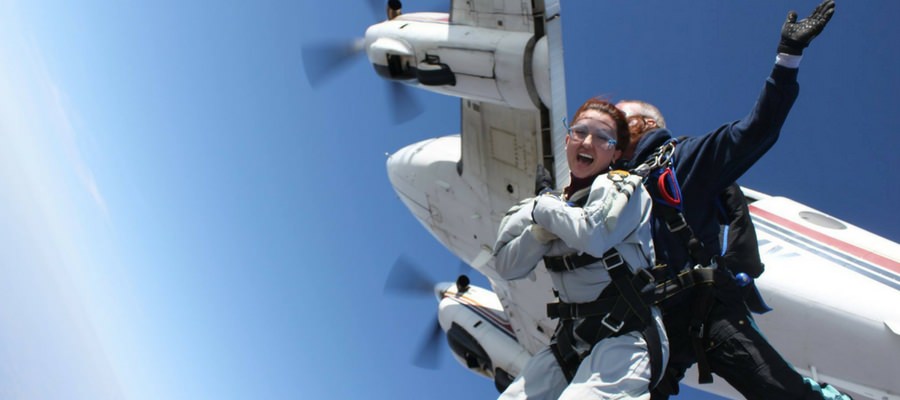USED TO BUYING BASED ON PRICE? DUDE. EVERYBODY IS.
Price buying is a part of our lives, for better or for worse. A few dollars’ savings drive us from mom-and-pop Main Street hardware shops to the big orange beasts on the edge of town. The collective cost of a latte can unanchor us from shopping days spent strolling from butcher to baker to candlestick maker, depositing us squarely in the overwhelming parking lot of a blue-logoed mini-city lit entirely by fluorescents. A few cents here and there keep us from buying eggs at the farmer’s’ market and going to tasteless factory-farmed battery versions; from buying clothes sewn down the street in favor of those cobbled together across the world. We happily trade craftsmanship for disposable utility. Usually, in these choices, we don’t actively face the consequences.
First-time tandem skydivers are not to be faulted for believing that this same philosophy is workable in the context of a skydive. In a moment when skydiving shows up next to half-price sushi on flash-deal websites, this is an easy mistake to make. Isn’t it just a ticket to ride, you might think, in the same style as an amusement park admission?
It’s, like, not.
A big problem in the skydiving industry today is the focus on buying based on price. Buyer beware, y’all. Cheaper isn’t always better, especially–and you know this already, intuitively–when it comes to this kind of detail-oriented, safety-requisite activity.
Here are the facts:
ANYTHING AVIATION-RELATED IS REALLY, REALLY EXPENSIVE.
In order to run a safety-first operation with staff, equipment and aircraft you can trust, a lot of money needs to go into training, care and maintenance. This is true in every single facet of aviation. It’s especially true in skydiving, which has multiple moving parts. Introducing new skydivers to the sport cannot be done on the cheap, for the safety of everyone involved.
HAVING TOP-SHELF STAFF DOES COST MONEY.
Our professional skydivers hold some serious certifications. They have, each and every one, put in hundreds of hours of training and completed thousands upon thousands of collective successful jumps. We trust them entirely–which is why we put them in such a responsible position. Skydiving dropzones that settle for less tend to suffer the consequences.
HIGH-VOLUME OPERATIONS OFTEN HAVE BURNT-OUT STAFF.
Going for a bottom-line price requires entirely too much of a professional skydiving staff. Since they’re forced to churn out a high volume of jumps, they get exhausted. Their customer service is clearly kneecapped, but there’s another important element of their toolkit that suffers: reaction time and alertness. We are passionate about giving our tandem instructors appropriate workloads that allow them to effectively do their high-pressure job with a big smile on their faces. And we do! You’ll notice it immediately.
GOOD DROPZONES HAVE A PAPER TRAIL.
If a DZ is good, you can be assured that it will have a positive reputation in the industry. The cornerstone of our dropzone’s reputation were already being set down in the 1980s, when our owner–Chris Hall–was a child, watching his father skydive from the ground and learning everything he could about the sport. He’s been an active skydiver since 1990, and has dedicated his life to picking up nearly every skydiving rating in existence and building the most positive, motivated, customer-oriented team on the planet.
Even if a dropzone isn’t lucky enough to have a pedigree like ours, they should at least have a USPA Group membership (which materially proves their dedication to safety) and a long litany of five-star reviews, all over the internet. Fly-by-night, cut-rate dropzones looking to make a windfall won’t have either.
At the end of the day, remember: A brilliant skydive really is priceless. It’s a life-changing moment–and we’re looking forward to sharing it with you.

